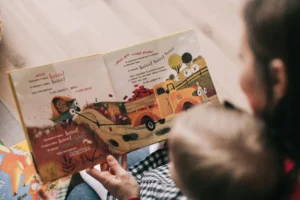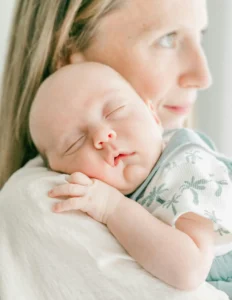Sharing your room with your little, aka room-share one can happen for a variety of reasons. You may not have enough space to create a bedroom for them, or you may have an older sibling who is distracted by the baby, or you may just want to bond with your baby. The American Academy of Pediatrics (AAP) encourages sleeping with your baby from their birth to at least 6 months, and 12 if the arrangement is working out well for both of you.
Keep in mind, that these are not mandates, merely suggestions, and if you prefer to not room-share, do not fret about it. There are no right or wrong answers, and every family has a different preference. Our focus at Rocky Mountain Sleeping Baby is to educate everyone on safe sleep and all of the services we offer assistance with to provide you with enough information for you to decide if you want to pursue this route with your little one.
We have worked with many families to begin or tweak room-sharing, and our certified sleep experts at Rock Mountain Sleeping Baby have created helpful strategies for you as you begin this journey.
What Room-Sharing Means:
Room-sharing is simply sharing your bedroom with your baby. It does not mean your baby or toddler sleeping in a bed with you. A room-share setup would consist of a bed for you and/or your partner to sleep in, and a bassinette/crib for your baby to sleep in.
There are terms such as co-sleeping, or bed-sharing that refer to a baby sleeping in the same bed as you. We have discussed in previous blogs the safety and the potentially negative impact sleeping with your baby or toddler can create.
If you would like to have a conversation about co-sleeping or bed-sharing, please give us a call or email and one of our sleep experts will be happy to discuss it with you. For this blog, we are focusing on room-sharing alone.
Feig-Shui in the Bedroom
Creating the ideal room set up for both you and your baby can be a little like playing Tetris. You will want to focus on a few important tips that create a cohesive space for both of you.
In several blogs, we discuss the importance of keeping the room pitch black. If you watch TV in bed or play on your phone or iPad, we suggest you do this in another room so that when you are entering the room for the night it is to go straight to sleep to keep the room as dark as possible. Even if your baby is asleep, the light from any device can easily wake them up and cause a distraction to them.
When you first bring baby home from the hospital until about 3 months, it is standard to have them very close to your bed. Around 6-8 weeks, move their crib to the opposite side of the room to give enough space between you where you can enter your bedroom, move around comfortably, and get into bed without it becoming a distraction or waking them. Babies can be light sleepers and being too close to them can awaken them easily.
Keeping the Room Dark
We have stressed the importance of what we call a blackout room. This means blackout curtains on the windows to discourage any sunlight from peeking through. Amazon sells a variety as do many department stores or home furnishing stores such as Kohls, Home Goods and more. I also love the Blackout EZ blinds!
Alarm clocks should be avoided or have a display that can be dimmed unless going off or tapped to see the time. Nightlights are another big distraction and should be avoided if possible. Keeping the crib on the opposite side of the room when your little one is older helps you with a path to your bed where you will have enough room without stubbing a toe or tripping over anything.
Noise Machines
Our sleep experts have shared tips on white noise machines in a previous blog, if you would like to learn more about white noise and where to buy, click here.
A white noise machine can help your baby stay asleep when you enter the room as you may likely not be going to bed at the same time as your little one. The machines should be kept where babies cannot reach them, and about 3-4 feet away from their crib. The idea decimal for a white noise machine is between50-60, and no higher than that. Or you can use the conversation test. If you find yourself speaking loudly to someone else in the room, it is too loud.
Music from your phone, or radio is not the same as white noise. If you have fallen asleep to music prior to room-sharing and absolutely rely on it, we suggest noise-canceling earphones or buds where the sound will only be heard by you when worn, and low enough that your baby cannot hear the music at all.
It is important to use only white noise. Settings such as ocean, rain, heartbeats, etc. can seem nice but they have an ebb and flow to them. This change inconsistency can actually disrupt your baby’s ability to connect sleep cycles.
Speaking of noise, do you have a creaky door? Is there an area on the floor that creaks a little when you walk on it? These little nuances may not bother you as you are used to them, though they are new to your baby and will be a distraction. A little WD40 can help relieve a squeaky door or floorboard.
Let the Slumber Party Begin
At Rocky Mountain Sleeping Baby, it is our mission to help as many families as we can with sleep training. Our certified sleep experts have created a tried-and-true system that teaches you and your partner how to sleep train babies from infantry to toddler years and beyond to provide them with habits that will last a lifetime, and not only that, will have amazing health benefits, too. You can learn more about sleep training in previous blogs or set up a consultation with one of our certified sleep experts to get started.
There will be nights that baby will wake up and see you and demand your attention. They may not be hungry, or need a diaper change, they may just have awoken and sensed you were nearby, and they don’t want to be up alone in their middle of the night crib party.
Room-sharing will have ups and downs as you begin to navigate this process. There will be many trial and error nights until you have a pattern and schedule down, and it can be a little frustrating to get there. You are not alone in this, and if you feel overwhelmed or frustrated don’t get down on yourself. Being a parent is tough, and when you are tired or learning a new schedule and system, it can feel very isolating. As parents ourselves, we get it. Our solutions have been tested on our own families too, and through the years our sleep consultants have perfected these systems.
To sum up, room-sharing remember these little tips, and we are so thankful that we can share our expertise with you. Being a parent takes a village, and we are thankful you are part of ours.
- 0 to 3 months; bassinet, Pack n Play or crib can be by the bed
- 3-12 months; crib should be on the opposite side of the room, with some sort of divider between you.
- Complete darkness is key. Blackout blinds and/or shades are ideal
- White noise machines, no louder than 50-60 decibels will help mask any movement you make entering or leaving the room as your baby sleeps.
- Eliminate the TV, phone, tablet, night-light, alarm clock, or other devices with lighted displays on them.
- Find squeaks such as a door, dresser, floor, etc. to see if WD40 can help.
- Read through our previous blogs on creating a dark room, sleep-training, or others that may aid as you begin room-sharing.
- Remind yourself there will be great days, and not-so-great days. Embrace them all and know that it is only temporary and reach out. Do not bottle your emotions in or be afraid to ask for help.
Thank you for taking the time to read our blog. Feel free to leave a comment below. If there are topics we have not covered, please let us know. We welcome suggestions to better help all of you.
As always, we are sleep consultants in Denver, Kansas City, and Ft. Worth. However, everything we do is virtual. We work with families all over the world!





